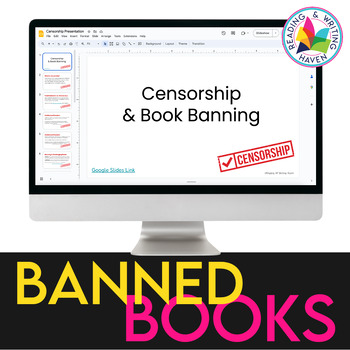Literary Censorship and Banned Books Lesson Mini Unit
- PDF
- Google Apps™

What educators are saying
Description
Want to teach students about banned books and the perils of censorship? Try this engaging mini unit on literary censorship with regards to banned and challenged books. This unit is perfect for September as it is Banned Books Month, for a genre study, for an independent novel study, for a common literature circle theme, for book club, or for a controversial issue unit, among many other possible options.
This mini unit features engaging lessons and student-centered activities to keep students engaged and help them see the relevance of the topic:
1. A KWLS anticipatory activity to engage students and establish baseline understanding about censorship and banned books buzzwords
2. An editable censorship and banned books slideshow with links to pertinent video clips
3. A kinesthetic banned books sorting activity
4. A censorship jigsaw group activity featuring student-led discussion and research - includes an answer key
5. An essay writing extension activity with six different prompt choices for differentiation and an editable rubric
6. An editable letter to parents explaining the necessity and purpose of the unit
7. A suggested banned books mini-unit plan
Many students have no idea that censorship even applies to books. They don't understand that the First Amendment protects their right to read and that they have a right to Intellectual Freedom. They don't usually understand the process a book goes through to become banned or even where it is banned after a challenge has been made against it.
Let's educate our students on censorship. Whether we are for it or against it, students need to know that it's a debatable issue in our society today.
***All files are editable in Google Drive and can be downloaded as PDF or Microsoft PowerPoint and Word documents.
Looking for additional reading engagement materials for your middle or high school ELA class? You might enjoy:
- Book Club or Other Independent Choice Reading Program Teaching Materials Bundle
- Analyzing Texts Bundle
- Summarizing Nonfiction Texts
Interested in browsing other unique ELA teaching materials from The Reading & Writing Haven? You can do that here!
~~~~~~~~~~~~~~~~~~~~~~~~~~~~~~~~~~~~~~~~~~~~~~~~~~~~~~~~~~
A Couple Tips:
* Be sure to click the "follow" button that is located next to my picture so that you can hear about sales and new products!
* By providing feedback on your purchased products, you can earn points, which ultimately translate into cash toward future purchases...bonus! Plus, I'd love to hear from you.
©Reading and Writing Haven
All rights reserved by author.
Duplication limited to single classroom use only.
Electronic distribution limited to single classroom use only.





